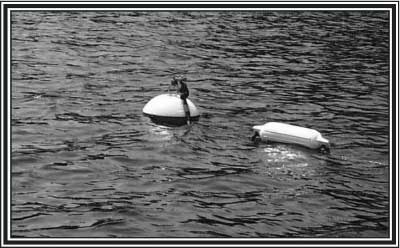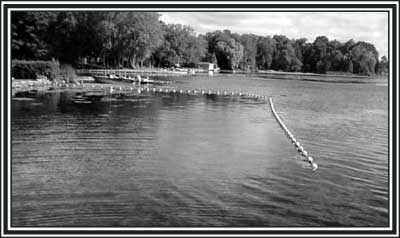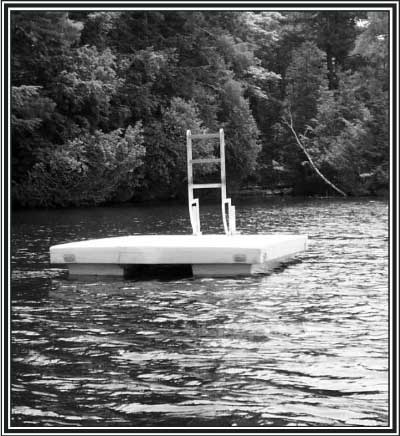page15
[ Previous | Table of Contents | Next ]
14. MOORING BUOYS, SWIMMING BUOYS, RAFTS AND WATER SKI COURSES AND RAMPS
CONTEXT
These types of floating facilities are installed offshore to allow for recreational use of the water surface. If carefully installed and maintained, the environmental impact can be negligible as all that is required is an anchor to secure them to the bottom.
Potential implications of these facilities can be:
- Hazard to navigation;
- Noise;
- Breaking loose of anchor cables;
- Obstruction of other waterfront recreational uses;
- In the cases of water ski courses and ramps, high speed vessels in proximity to the shore.
The following policies apply to these facilities.
POLICIES
Mooring Buoys
- Mooring buoys will only be allowed in exceptional circumstances, e.g. where there is insufficient depth for a deep draft vessel near shore, and only for the mooring of a vessel owned by the adjacent waterfront property owner.

© Parks Canada - The anchor to secure the buoy shall be sufficiently heavy to prevent movement.
- The chain shall be of an adequate strength to provide a secure, permanent connection; its length shall be no less than twice and no more than three times the depth of the water.
- The mooring swing, that being the combined length of the chain from the anchor to the buoy plus the mooring rope from the buoy to the boat plus the length of the boat, must be more than 4.5m (15 ft.) from the side lot line as projected into the water and at least 30 m (100 ft.) from the navigation channel.
- The mooring buoy must be as close as possible to the property of the boat owner and located directly in front of the boat owner’s property.
- The moored boat must not interfere with access from neighbouring properties to the navigation channel or interfere with traditional recreational use patterns and activities on the waterbody.
- Mooring buoys must come under license for the occupation of the bed of the Canal or Waterway.
Swimming Buoys
- Approval must be received from Transport Canada, Small Buoy Regulations, in addition to an approval from the Rideau Canal or Trent–Severn Waterway. Private swimming buoys must comply with private buoy regulations.
- The swimming buoys shall not extend closer than 4.5 m (15 ft.) to either side lot line projected into the water
- The placement of the swimming buoys shall not interfere with access to or from neighbouring properties, or with traditional recreational use patterns.
- The swimming buoys shall be removed from the water at the end of the swimming season.

© Parks Canada
Swimming Rafts
- The raft must be connected to an anchor with a chain, with a 360 degree swivel at the anchor.
- The size can be no greater than 3 m x 3 m (10 ft. x 10 ft.) and the deck must be at least 50 cm (20 in.) above the water.
- The raft must be as close as possible to the shore but no more than 30 m (100 ft.) out from shore, and must be at least 15 m (50 ft.) distance from the edge of the official navigation channel of the Trent–Severn Waterway or Rideau Canal where such applies.
- The raft must be removed from the water at the end of the swimming season.
- The raft must be at least 4.5 m (15 ft.) from the side lot lines as projected into the water and located directly in front of the owners property.
- The raft must not interfere with access from neighbouring properties to the navigation channel or interfere with traditional recreational use patterns and activities on the waterbody.
- Approval must be received from Transport Canada in addition to approval from the Rideau Canal or Trent–Severn Waterway.

© Parks Canada
Water Ski Courses and Ramps
- The facility must be approved by Transport Canada and Parks Canada.
- The ramp must be connected to an anchor with a chain.
- The course and ramp must be located in an area that will not interfere with navigation, other recreational users or cause undo noise to waterfront property owners.
- An annual permit is required for all water ski courses and ramps.
- The course owner is responsible for the removal of skier turning balls when the course is not in use and all course markers must be removed by the end of October each year.
- The course owner has the right to determine who uses the course, is responsible for all course users and for instructing these users in proper course etiquette and applicable ski course conditions and restrictions
- The course owner must acquire liability insurance in the amount of two million dollars and the insurance must be valid for the time period the course is in use.
- The ramp must be removed from the water each winter.
- The ramp must not interfere with access from neighbouring properties to the navigation channel or interfere with traditional recreational use patterns and activities on the waterbody.
- The facilities are located a minimum distance of 150 m (500 ft.) from cottages or residences (unless consent is given in writing), beaches, camp grounds, marinas, or commercial docks (unless consent is given in writing), water fowl nesting areas, fish spawning beds, erosion prone banks, traditional angling spots, or any structure and 61 m (200 ft.) away from any navigation channel.
- The facilities are located a minimum of 30 m (100 ft.) from any shore.
- Local residents, landowners and waterway users must be given an opportunity to comment (referral by letter to residents and landowners and by newspaper ad for water users) on the location of the course.
- Water depths are conducive to installation in the area proposed.
[ Previous | Table of Contents | Next ]
Related links
- Date modified :


